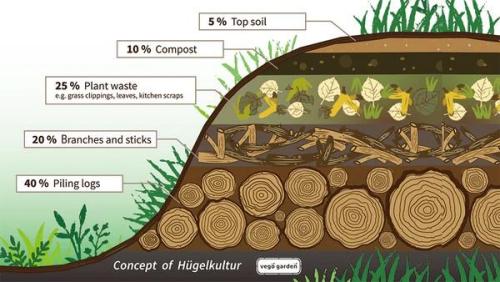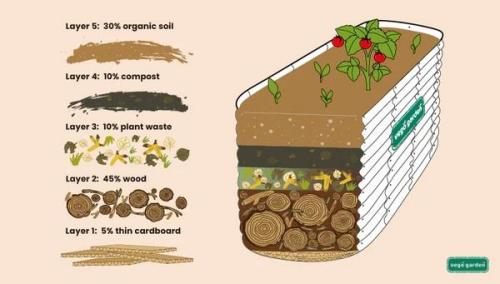To save on filling material and to create a rich, fertile planting environment for many seasons to come, I plan to use the Hugelkultur Method. This is a growing method I wanted to try this coming Spring. Hugelkultur does not require the use of an elevated bed. It can be done just by creating a pile, but the elevated bed does a good job of keeping the hugelkultur contained. Here is a detailed explanation of Hugelkultur for elevated garden beds for those who may not be familiar with it. After reading, you can see why Hugelkultur is a very popular permaculture method for growing.
Summary
Hugelkultur is the process of layering organic garden waste inside the raised garden bed, before adding soil to save on costs, in addition to attracting and preserving moisture. Of German origin, hugelkultur translates to "mound or hill culture." It is especially applicable in areas where soil retention and drainage are poor, which is typical of soils found in urban areas.
The Hugelkultur Method to Fill Raised Garden Beds
The materials used include large rotting logs, sticks and other debris that are layered with grass clippings, coffee grounds, compost, and other organic matter. As the material breaks down, it creates a flourishing environment for beneficial fungi and microbes that mimics the natural landscape of a forest. There are many advantages to the Hugelkultur method, including soil quality improvement, minimal maintenance, and water retention.
To create a bountiful garden bed, organic matter such as rotted hay, plant waste, and compost is added to the soil. Wood debris decomposes slowly, making it a stable source of organic matter. The optimal kind of wood used is one that is starting to rot, which can be obtained from branches cut from a dead tree or logs from an abandoned wood pile. This organic matter will decompose over time, and plant roots will travel deeper into the raised garden bed soil to obtain the nutrition. It will also work as a big sponge, retaining water to maintain an ideal moisture level.

In the Hugelkultur method, for filling a raised garden bed, the large pieces are laid at the bottom as they will take the longest time to decompose. In the picture above, the piling logs may take up to 5 years before the base sponge breaks down into rich, wonderful, raised garden bed soil. The smaller pieces are placed on top of the larger pieces to fill space, such as branches and sticks, and then grass clippings, leaves and kitchen scraps. Compost and topsoil are on the top two layers for your raised garden bed so you can start planting as the organic matter beneath decomposes.
Some Considerations While Filling a Raised Garden Bed Using Hugelkultur Method
Pests: Something to be aware of are termites, especially if you live in a wooded area with a high termite distribution, which can be attracted to the large amount of buried wood. However, most termites tend to live in dead trees that are still standing, rather than buried logs found in hugel beds. Garlic can be grown for pest control. Make sure to be vigilant against pests such as slugs, snails, and pill bugs. You can use organic pest control such as beer traps if slugs become a problem.
Various Hugelkultur Methods: The classic method requires you to dig a deep trench around 2 meters and fill it with large logs, adding progressively more logs until it becomes mound-shaped. Most gardeners dig a shallower trench that is about 1 meter. Vego raised garden beds provide a convenient alternative that only requires you to fill the container on the ground with the appropriate contents. They provide structural integrity through an enclosed terrain that is easy to manage and will last for many years, making it the perfect framework. That way, you don't have to spend time digging a trench or placing a fence around it, which can be burdensome and labor intensive. Additionally, it is more aesthetically pleasing than just a mound on the ground, which is unsightly to some.
Wood Type: The right type of wood is important to consider. Hardwoods are recommended as they break down more slowly and hold water longer. However, softwoods are also acceptable. The woods that work best include birch, alder, maple, cottonwood, willow and oak. Avoid allelopathic trees like black walnut, red oak, and sycamore, as they contain chemicals that inhibit plant growth, as well as rot resistant trees like black cherry and black locust.
Preparation: Be sure to add a fresh layer of compost on top prior to planting. The combined layers of organic material above the wood should be as deep as the wood base. This means a 30" bed can have up to 15" wood in it, while a 15" bed will have 6" wood to allow enough space for the growing medium.
Moisture Levels: Maintaining moisture is an important aspect of hugel garden beds, as dryness is a commonly reported issue. Therefore, it is important to shift the soil into crevices to eliminate any dry pockets. One way to accomplish this is to continuously water the bed during construction to make sure there are no gaps. You should also use a good quality organic mix soil, which improves water retention.
Hulgelkultur Method Advantages
Using the Hugelkultur method for filling raised garden beds has many advantages and has been proven to work. If you are seeking to cut down on costs, or looking for a sustainable gardening technique, then this method is for you. The vertical nature of the mound helps maximize surface area, which is useful in compacted, urban areas. Therefore, it is a method that is suitable for farmers, gardeners, and homeowners.
Cost Efficient: Buying bags of soil from a store is quite costly, which can amount to over a hundred dollars for large garden beds. The Hugelkultur method turns garden and kitchen waste into useful material for filling raised garden beds, allowing you to save a substantial amount of money. You can also repurpose fallen tree branches or dead branches cut from trees instead of carting them away or burning them. The organic waste will decompose over the years, enriching the soil and providing steady nutrition for plants to use.
Environmentally Friendly: When branches are burned, gasses and nutrients are released into the atmosphere, which contributes to global warming. By retaining them in the ground, they undergo carbon sequestration, a process that reverses CO2 pollution and mitigates climate change.
Water Retention: Hugelkultur tends to hold water very well since the garden waste works as a sponge to hold moisture, releasing rainwater into the soil during dry seasons. This allows gardeners to save on water costs by reducing the frequency of watering. In addition, you don't have to worry about overwatering your plants to the point they become waterlogged, which is detrimental to root growth and can choke out oxygen.
Soil Temperature: While compost is decomposed by bacteria, hugel beds are primarily decomposed by fungi. As the organic matters decompose, they will heat up and create a microclimate under the plants, and warm the raised garden bed soil, which can be very helpful in colder climates.
Soil Improvement: Hugelkultur also creates a mini biosphere consisting of microorganisms, fungi, and insects, emulating the natural landscape of a forest, with its spongy, nutrient rich soil teeming with microorganisms. Because the soil is naturally aerated, it employs a gardening technique known as no-till gardening. Plants grown in this manner are more resilient to disease, pests, and environmental stressors. They are also more flavorful due to the abundant nutrients.
Minimal Maintenance: Although the initial setup takes some effort and preparation, there is not a lot of maintenance involved in these garden beds once they have been constructed. You only need to minimally maintain the garden bed by occasionally adding a couple inches of compost and fertilizers to the top to replenish it. They also require minimal weeding compared to conventional beds.
Vego Garden, the company from which I ordered an elevated bed the other day to try, offers this diagram for Hugelkultur in their 32" tall bed. It can easily be adjusted to any height using the two pictures in this post. (Not sure why they recommend the 5% of thin cardboard on the bottom since I could not imagine grass/weeds growing up through this. Since I will be placing the bed on ground that has already been covered with cardboard/wood chips for over a year, I will skip the cardboard and just start with the logs.)


